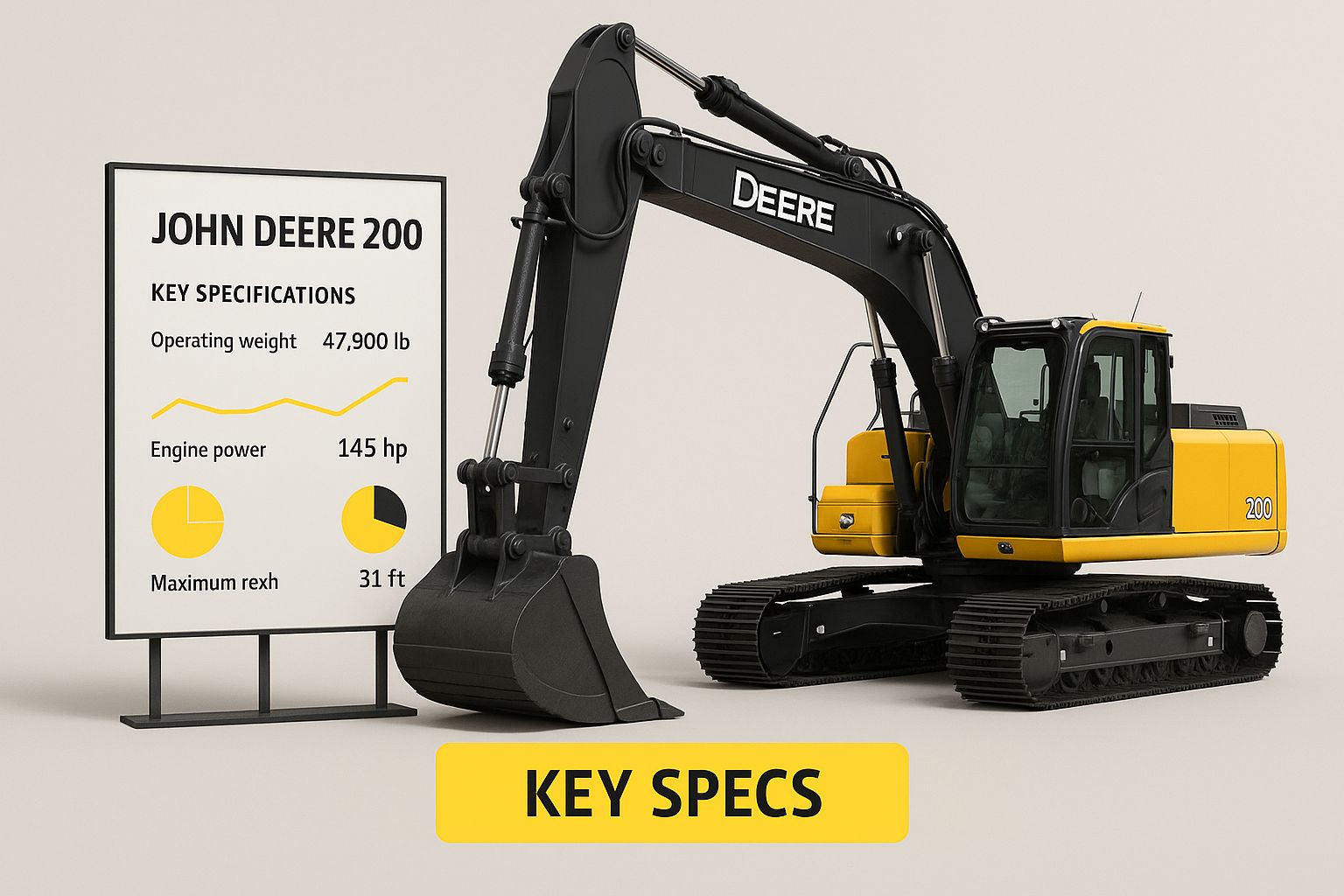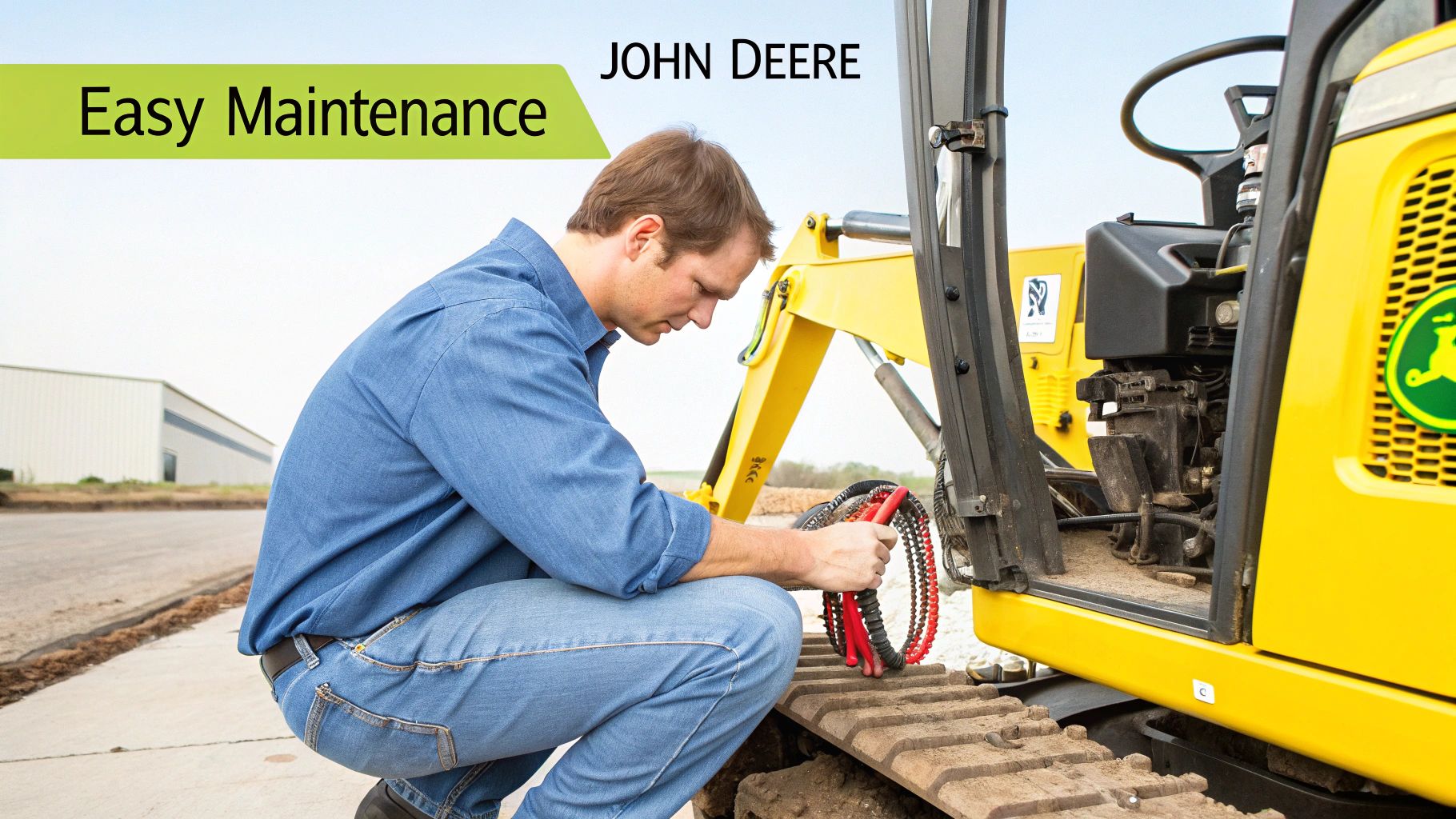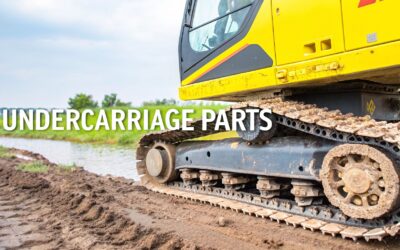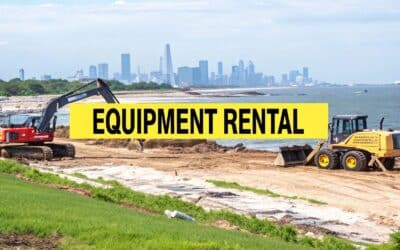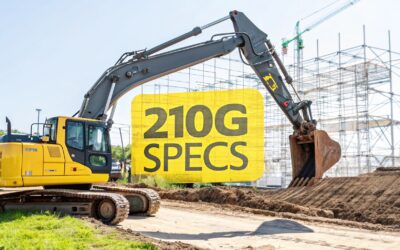When discussing mid-size excavators, the John Deere 200 trackhoe inevitably enters the conversation. It's a machine that has earned its reputation on countless job sites, becoming a trusted piece of equipment for project managers in some of the toughest industries. For years, it has been a go-to solution for its blend of power, reliability, and versatility.
But what happens when the job site is not solid ground? Many of today's most critical projects in land reclamation, pipeline installation, and environmental cleanup occur in swamps, marshes, and saturated coastlines. A standard excavator would sink, but this is where the John Deere 200's potential truly shines. By transforming this land-based workhorse into an amphibious powerhouse, operators can conquer environments once thought unreachable.
The John Deere 200 Trackhoe: A Legacy of Power
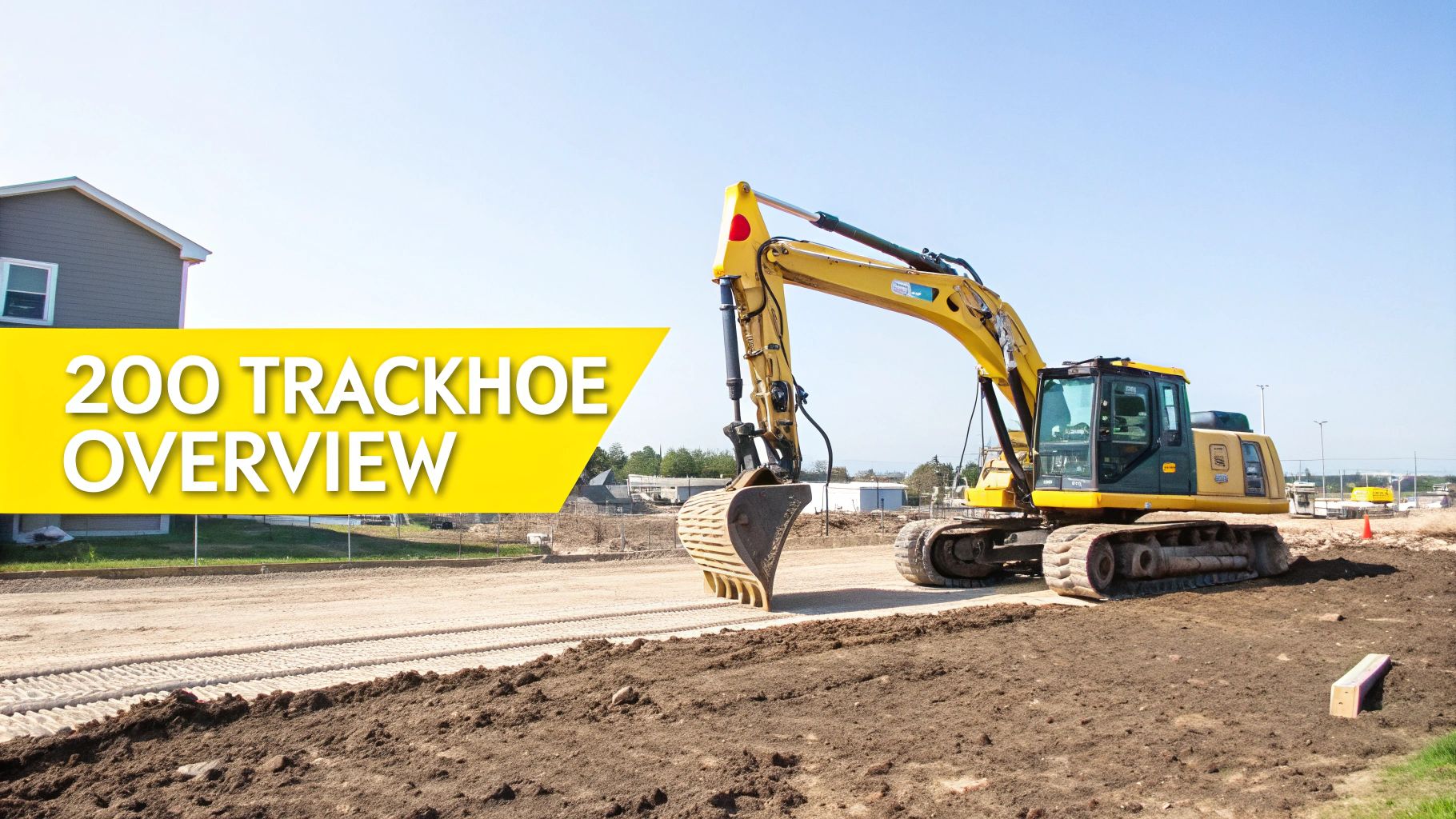
The JD 200 series built its legacy by consistently performing on demanding construction, excavation, and utility projects. It occupies a sweet spot for operators, delivering ample digging force and lifting capacity while remaining nimble enough for jobs that require precision.
Its real strength, however, is often hidden. While it is a champion on solid ground, many of today's most critical projects are in places where land and water meet. These environments are no-go zones for standard heavy equipment, and that is where the biggest challenges often lie.
From Land-Lover to Amphibious Powerhouse
This is precisely where the John Deere 200 platform excels. Its solid engineering, from the robust hydraulic system to its durable frame and reliable engine, makes it the perfect base for an amphibious upgrade. With a specialized undercarriage, this workhorse can be completely re-imagined to work in places that once seemed impossible to reach.
This kind of modification is not just a novelty, it opens the door to essential projects that protect our environment and build our infrastructure. A few key applications include:
- Environmental Cleanup: Accessing sensitive wetlands to perform restoration work without damaging the ecosystem.
- Pipeline Installation: Laying and servicing pipelines through swamps and marshlands, which is often the most direct and necessary route.
- Land Reclamation: Transforming waterlogged, unusable areas into stable ground for development or agriculture.
- Dredging Operations: Clearing and deepening waterways in shallow or confined areas where a traditional barge cannot fit.
The logic is straightforward: a great amphibious machine starts with a great excavator. The JD 200 brings that proven, reliable foundation to the table, ready to be outfitted for the most demanding aquatic jobs.
At Wilco Manufacturing, we see the JD 200 for its full potential. We take John Deere's trusted engineering and pair it with our specialized amphibious solutions to create equipment that redefines what is possible. Understanding the unique demands of these challenging terrains is key to building effective equipment for dredging and other amphibious projects. Let's dig into the specs and applications that make this trackhoe an exceptional choice, both on land and in the water.
Getting to Know the John Deere 200 Series Specs
To fully appreciate a John Deere 200 trackhoe, you must look past the model number and get into the details of its specifications. For any decision-maker managing a job site, these numbers translate directly into how well the machine performs, how efficient it is, and ultimately, how profitable your project will be. Specs like engine power, hydraulic flow, and digging depth define exactly what a machine can do.
Once you understand these core numbers, you start to see why the JD 200 series is such a solid foundation for both standard earthmoving and specialized amphibious work. It achieves a perfect balance between size, power, and fuel economy that makes it a workhorse in any fleet. When you take that solid engineering and pair it with a purpose-built undercarriage, its capabilities expand into whole new territories.
The Numbers That Really Matter on the Job
When evaluating an excavator, a few key figures tell you almost everything you need to know. These are the stats that define what the machine is built for, whether that is digging deep utility trenches or carefully moving heavy materials. A good handle on these numbers helps you match the right machine to the right job, every time.
Here are the essential performance metrics for any John Deere 200 trackhoe:
- Engine Horsepower: This is your raw muscle. More horsepower lets the machine run its hydraulic systems at full capacity and power through tough ground without bogging down.
- Operating Weight: This number speaks to the machine’s stability and how much it can lift. A heavier excavator is a more stable platform for deep digging and can handle bigger loads with confidence.
- Digging Depth and Reach: These specs map out the excavator's working area. You need serious digging depth for tasks like foundation work, while a long reach is a must-have for clearing wide areas or loading trucks from a distance.
- Hydraulic Capacity: This is the machine's lifeblood, measured in flow (gallons per minute) and pressure (psi). A strong hydraulic system means faster cycle times and more power for running attachments like hammers or grapples.
This graphic gives you a quick visual breakdown of the key specs for a popular model, showing how all these numbers come together in the real world.
As you can see, the John Deere 200 is all about balance. Its power, weight, and reach exist in a harmony that creates one seriously capable excavator.
Comparing John Deere 200 Series Models
The 200 series is not just one machine, it is a family that has evolved over the years, with each model bringing something different to the table. Knowing the difference between an older classic like the 200C LC and a newer machine like the 200 G-Tier is key to picking the right platform for your operation. The 200C LC, for instance, is an industry legend known for its bulletproof reliability and no-nonsense design, making it a smart, dependable choice that will not break the bank.
Built from 2002 to 2007, the John Deere 200C LC truly made its mark. With a hydraulic system pressure of 4980 psi and a bucket capacity around 1.2 cubic yards, it found that perfect blend of power and efficiency. Its continued popularity across the US, Canada, and Europe is no accident, a strong parts network keeps these machines running, minimizing downtime and extending their working life for years.
Newer models like the 200 G-Tier build on that legacy, bringing in modern technology that focuses on better fuel economy and a more comfortable operator cab. Both are fantastic machines, but the best one for you comes down to the job at hand and your budget. You can see the wide range of excavators that serve as base models for our amphibious systems to get a better idea of their versatility.
To help you see the differences more clearly, we have put together a quick comparison of these two popular models.
John Deere 200 Series Model Comparison
| Specification | John Deere 200C LC | John Deere 200 G-Tier |
|---|---|---|
| Net Power | ~141 hp | ~146 hp |
| Operating Weight | ~45,400 lbs | ~45,170 lbs |
| Max Digging Depth | 21 ft 11 in | 21 ft 11 in |
| Max Digging Reach | 31 ft 10 in | 32 ft 7 in |
| Hydraulic Flow | ~116 GPM | Variable, managed by Powerwise Plus |
This side-by-side view shows the slight bump in power and reach you get with the newer model, along with a more sophisticated hydraulic system. But the core performance is remarkably consistent, which is exactly why the entire 200 series has earned its reputation as a name you can trust.
Standard Applications on Solid Ground
Before you can consider putting a John Deere 200 trackhoe in the water, you must understand why it is such a capable machine on dry land. This machine earned its reputation as an industry workhorse by delivering consistent, reliable performance on countless traditional job sites.
For decision-makers in construction, demolition, and utility work, the JD 200 is a go-to piece of equipment. It achieves the ideal combination of power, precision, and efficiency that projects demand. Understanding what it does day-in and day-out on solid ground provides the perfect baseline, showing us exactly why this machine is the ideal candidate for an amphibious conversion.
Construction and Site Development
Walk onto almost any residential or commercial construction site, and you will likely find a John Deere 200 trackhoe carving out the earth. Its impressive digging depth and reach make it the perfect tool for excavating basements or digging footings for large structures. The machine’s rock-solid stability gives operators the confidence to hoist and place heavy materials, like precast concrete sections or large pipes, with pinpoint accuracy.
Site preparation is another area where this excavator truly shines. Whether it is clearing land, grading a site for proper drainage, or trenching for utilities, the performance is always on point. Its hydraulic system is incredibly smooth, giving operators the fine control needed to achieve the correct grade and ensure the site is perfectly prepared for the next phase.
A well-prepared site is the cornerstone of any successful construction project. The precision of a John Deere 200 trackhoe ensures that foundations are dug to the exact specifications, preventing costly delays and structural issues down the line. This level of control directly impacts project safety and quality, setting a high standard right from the start.
Road Building and Infrastructure Projects
Building roads and maintaining public infrastructure is demanding. It requires equipment that can handle long hours and tough conditions without issue. The John Deere 200 trackhoe is a familiar sight on these projects, doing everything from cutting embankments to laying large-diameter culverts. Its rugged construction means it can operate in all sorts of ground conditions, from soft clay to tightly packed gravel.
For a typical road-building job, its role is crucial:
- Excavating Roadbeds: It moves huge volumes of earth quickly to get the grade right for new roads.
- Loading Haul Trucks: With fast cycle times and serious lifting power, it keeps material flowing and the project on schedule.
- Placing Riprap: Operators can carefully position large rocks to stabilize slopes and prevent erosion along highways and bridges.
Reliability is everything here. Infrastructure projects often have tight deadlines with public money on the line, so equipment downtime is not an option. The JD 200’s proven track record gives project managers peace of mind that it will show up and perform, day after day.
Demolition and Pipeline Work
When it is time for a structure to come down, the John Deere 200 trackhoe becomes a powerhouse of demolition. Outfit it with a hydraulic hammer or a set of shears, and it is ready to go to work. The machine's hydraulic system delivers the flow and pressure needed to run these high-demand attachments, allowing operators to dismantle structures piece by piece with surgical precision. This helps separate materials for recycling and keeps the job site safe.
It's a similar story for pipeline installation on stable ground. This trackhoe is invaluable for digging long, consistent trenches for oil, gas, and water lines while holding the exact depth and slope required. It can then carefully lower heavy pipe sections into the trench and handle all the backfilling, making it a complete solution for pipeline contractors.
All of these land-based applications prove the machine’s core strengths, from its powerful engine and responsive hydraulics to its durable build. This solid foundation of performance is exactly what makes the John Deere 200 trackhoe such a capable platform when it is transformed for the unique challenges of amphibious work.
Taking the Trackhoe Where It's Never Gone Before
A John Deere 200 trackhoe is a powerful machine on solid ground. But what happens when that ground turns to mud, swamp, or open water? For crews working in wetlands, along shorelines, or in flooded disaster zones, a standard excavator is useless. This is the exact problem we solve with custom amphibious engineering.
By swapping out its standard tracks for a specialized amphibious undercarriage, a conventional JD 200 is completely transformed. It becomes a machine that can not only navigate but thrive in saturated soil, shallow water, and delicate marshes. This is not just a simple add-on, it is a fundamental change that opens up a whole new world of previously unreachable job sites.
How an Amphibious Undercarriage Actually Works
The heart of this transformation is the amphibious undercarriage itself. At Wilco, we design these systems to do two things exceptionally well: float and move. The entire concept hinges on replacing the excavator's tracks with a pair of massive, sealed pontoons.
These pontoons are meticulously engineered to displace enough water to keep the entire machine, including the hefty excavator upper, buoyant and stable. Their massive footprint spreads the machine's weight over a huge area, which is key to preventing it from sinking into soft mud, sand, or fragile wetland terrain.
But floating is only half the battle. Our undercarriages are hydraulically driven, tapping directly into the John Deere 200's own powerful hydraulic system. The excavator's engine powers the tracks on the pontoons, allowing the machine to propel itself through water and across soft ground with surprising ease. This functionality is essential for project success in dredging and pipeline installation.
A Perfect Match: The John Deere 200 Platform
The process of converting a JD 200 is an exercise in precision engineering. We carefully lift the excavator's upper structure off its factory track frame and mount it onto a custom-built center frame attached to our amphibious undercarriage. All the hydraulic lines are then expertly rerouted to power the new pontoon drive motors.
The beauty of this integration is that the operator controls the machine with the same familiar joysticks and pedals. There is almost no learning curve, which means crews are productive from day one. This seamless fit is why the JD 200 is such a fantastic candidate for this kind of work.
Take the John Deere 200C LC, for example, a popular model built from 2002 to 2007. It came from the factory with a 141 horsepower engine and a hydraulic flow of about 116 gallons per minute. That is more than enough power to run the amphibious system effectively. Its reputation for reliability and the wide availability of parts make it a smart, durable investment for any amphibious fleet. You can dive deeper into the specs of the John Deere 200C LC on RitchieSpecs.
Solving Real-World Problems in Impossible Places
This ability to go from a land-based machine to an amphibious workhorse solves some of the biggest challenges for several industries. It is not just about reaching a tough spot, it is about working there safely and effectively.
- Environmental Cleanup: In delicate wetlands or contaminated rivers, these machines can perform remediation with minimal ground disturbance, protecting the very ecosystem they are there to save.
- Dredging and Waterway Maintenance: They are perfect for clearing out sediment and overgrowth in canals and coastal areas that are too shallow for traditional barges.
- Pipeline Work: For projects crossing swamps, an amphibious excavator can dig trenches and lay pipe without building costly and destructive access roads.
- Shoreline Restoration: Building breakwaters or restoring eroded coastlines becomes practical without damaging the sensitive environment you are trying to restore.
When you put a high-performance excavator on a floating platform, you erase the line between land and water. This gives project managers the confidence to tackle jobs they once thought were impossible, improving both their timelines and their environmental footprint. Ultimately, converting a John Deere 200 trackhoe is about breaking boundaries. It takes a machine celebrated for its power on dry land and gives it the tools to conquer the wettest, softest, and most challenging environments. Wilco's expertise in designing and building these amphibious hydraulic undercarriages makes it all possible.
Why the JD 200 Is an Ideal Amphibious Platform
Choosing the right excavator for an amphibious conversion is a critical decision. Not just any machine can handle the unique demands of working in wetlands, marshes, and waterways. You need a specific mix of power, ruggedness, and balance to create a platform that is both stable and effective. Time and again, the John Deere 200 trackhoe has proven to be an exceptional choice, providing the perfect foundation for Wilco's specialized amphibious undercarriages.
The JD 200 series has a well-earned reputation for a fantastic power-to-weight ratio, which is absolutely critical for flotation and stability on the water. Its tough construction means it can withstand the rigors of amphibious work, from churning through soft mud to handling heavy dredging attachments. When you combine John Deere's solid engineering with our purpose-built technology, you get a machine that is far more capable than either component alone.
A Foundation Built for Wet Environments
The John Deere 200 trackhoe has the right DNA for this kind of work. Its hydraulic system is more than strong enough to power the pontoon tracks, and its engine delivers the steady performance you need for long, hard days in tough conditions. Another huge advantage is the global availability of John Deere parts and service. When you are working on a project in a remote location, you cannot afford long downtimes, making that robust support network a game-changer.
This reliability solves real problems on the ground and in the water. For example, consider the newer 200 G-Tier model. It produces 146 horsepower with an operating weight of around 45,170 pounds, a perfect example of efficient power. Its smart hydraulics and impressive reach make it a beast for everything from environmental cleanups to pipeline work in saturated ground. You can learn more about the evolution of the John Deere 200 series and its G-Tier model here.
Gaining a Competitive Advantage with Wilco
Ultimately, putting a John Deere 200 on a Wilco amphibious undercarriage gives your business a serious competitive edge. This setup allows your crew to access job sites that are completely inaccessible to standard equipment. You minimize the environmental footprint by avoiding the need for temporary access roads or extensive matting. As a result, projects get done faster, safety improves, and you gain the ability to bid on, and win, specialized contracts that others cannot touch.
By starting with a machine you already trust and then giving it the ability to go anywhere, you open up a whole new world of possibilities. Your operation gains the flexibility to take on projects in swamps, deltas, and shallow waterways with complete confidence. An actionable takeaway for any project manager is to evaluate whether amphibious equipment could unlock new revenue streams or solve persistent logistical challenges. If your work demands access to the world's most challenging terrain, we are ready to help. See for yourself how a Wilco amphibious excavator can fundamentally change your operational reach.
Frequently Asked Questions
Considering an amphibious undercarriage for a John Deere 200 trackhoe? You likely have a few questions. This is a significant decision, and you need solid answers before you commit. We have compiled some of the most common questions we hear from decision-makers in industries like yours.
Whether you are planning a dredging job, an environmental cleanup, or pipeline work in a swamp, understanding the conversion process is the first step.
Can Any John Deere 200 Be Converted for Amphibious Use?
That is a great question. While most John Deere 200 series excavators are fantastic candidates, it is not a "one-size-fits-all" scenario. Before beginning any work, our engineers perform a thorough evaluation of the specific machine. This step is absolutely critical to ensure the final product is both durable and reliable.
Here’s what we look for during that initial assessment:
- Machine Condition: We check the core structure of the machine. The excavator's frame and key components must be structurally sound to handle the unique forces of working on water.
- Service Hours: A machine with fewer hours is often ideal, but a well-maintained, higher-hour excavator can still be a perfect platform for conversion.
- Hydraulic System Health: The excavator's hydraulic system is the heart of the operation, as it will power the amphibious undercarriage. We must confirm that the pressure and flow meet our standards to ensure smooth operation.
This detailed inspection ensures the converted machine will be safe, effective, and built to last for years of hard work.
What Is the Typical Lead Time for a Conversion?
The timeline to convert a John Deere 200 trackhoe can vary depending on our current shop schedule and the specific requirements of your project. We believe in being transparent from day one, so you will receive a realistic timeframe right after our initial consultation.
Generally, the process breaks down into three main stages:
- Initial Consultation and Machine Inspection: We start by discussing your project goals and giving the base excavator a full evaluation.
- Custom Fabrication: Next, we begin building the pontoons and all supporting framework, custom-made for your specific machine.
- Installation and Integration: Finally, our crew mounts the excavator's upper body onto the new amphibious undercarriage and connects all the hydraulic systems.
We strive to complete each phase as efficiently as possible without ever compromising on quality. The goal is to get your machine to the job site and generating revenue quickly.
How Is an Amphibious Excavator Transported?
Moving heavy equipment between jobs is always a major logistical challenge. We designed our amphibious undercarriages with that exact challenge in mind. An assembled amphibious excavator is too wide for legal highway transport, so we engineered the entire system for easy disassembly.
The pontoons are designed to detach from the main frame. This allows the entire unit to be separated into a few manageable loads that fit on standard lowboy trailers. It is a modular design that makes transport both legal and affordable, even to the most remote sites. This means your amphibious John Deere 200 trackhoe is not stuck in one place. You can deploy it wherever the work is, maximizing its value and your return on investment.
Ready to take your projects where traditional equipment simply cannot go? Contact Wilco Manufacturing to discuss our custom amphibious solutions for the John Deere 200 trackhoe. Our team is ready to help with the equipment, rentals, and parts you need to conquer any terrain.
